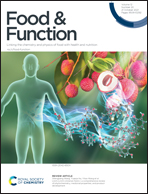Carboxymethyl chitosan coated medium-chain fatty acid nanoliposomes: structure, composition, stability and in vitro release investigation†
Abstract
Medium-chain fatty acids (MCFAs) have been proven as an easy energy source and active ingredient to prevent obesity and other metabolic disorders. However, the inherent hydrophobic nature of MCFAs causes poor aqueous solubility and dissolution in the gastrointestinal (GI) tract, thus limiting their applications in aqueous foods. To address these issues, a nutraceutical carrier system was developed by coating nanoliposomes with carboxymethyl chitosan (CMCS) through a series of well-designed processes, including thin-film hydration, dynamic high pressure microfluidization (DHPM) and surface modification. Electron microscopy investigation reveals an obvious morphology evolution from the uncoated nanoliposomes (UC-LPs) to the final CMCS coated nanoliposomes (CMCS-LPs). Together with the FTIR results, it confirms the successful coating of CMCS. More importantly, the resultant CMCS-LPs have a more negatively charged surface with a ζ-potential value of around −18.5 mV, which helps to increase the stability by avoiding severe particle aggregation. Owing to the above benefits, the encapsulated MCFAs can be safely retained in a long storage period of 90 days at 4 °C and the new carrier system also exhibits a more sustained release of MCFAs in the GI fluid.



 Please wait while we load your content...
Please wait while we load your content...